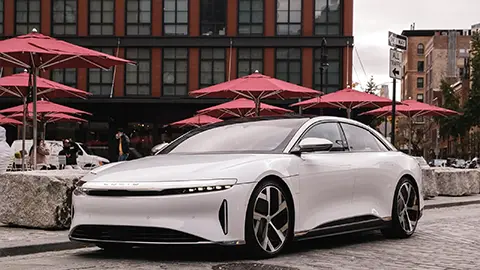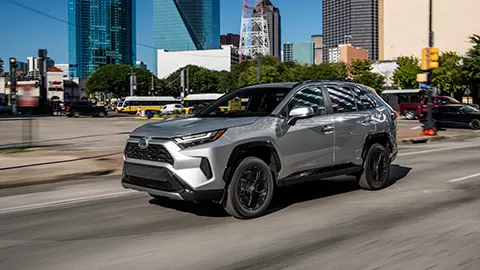Electric Car Range in Cold Weather
With the winter fully upon us in some parts of the country, we’re seeing more questions from potential electric car owners about how well popular electric car models perform in the winter – and specifically, how much range they lose in cold temperatures. Like gasoline cars, electric vehicles don’t go as far on a full “tank” of electrons as they do in ideal conditions. But EVs tend to lose more range in the winter – ironically because they are so much more efficient.
While a gasoline engine generates a lot of residual heat that can be used to warm the cabin in cold temperatures, electric cars have to actively heat the cabin and its occupants, drawing power from their batteries to do so. Still, according to a new study from industry data aggregator Recurrent Auto, some electric vehicles perform better in the winter than others – and some EVs can lose half their range when the temperature drops below freezing.
How Do I Choose the Best EV for Winter?
If you are shopping for an electric car, there are a number of features you should be looking for to minimize how much range you will lose in cold temperatures. In fact, we recently published a whole article about finding the best EV for winter driving conditions. If you’re regularly going to be driving your EV in cold weather, keep an eye out for the following:
- Heat pump: While all EVs have a resistive heater, which simply uses electricity to pass current through an electric conductor to generate heat, many electric cars have a more efficient heat pump. Heat pumps work like an air conditioner in reverse, to move heat gathered from both within and outside the vehicle and boosting its temperature. They can save up to 8 kW of consumption – significantly improving range.
- Heated seats and steering wheel: An even more efficient way of getting warm in a car is to warm your body instead of the air in the cabin. Heated seats and a heated steering wheel will help you feel more comfortable while reducing the burden on an electric car’s heating system.
- Pre-heating and pre-cooling: You can gain a lot of range by having the vehicle at your desired temperature before you drive off. Using the pre-heating feature lets you program your desired departure time; your EV heats the cabin to the desired temperature while it’s still plugged in. This has two benefits: you get into a warm car, and you don’t need to use battery power on the go to warm the cabin up.
- Pre-conditioning: Batteries charge faster when they are at their optimum operating temperature. Linked to your vehicle’s navigation system, the pre-conditioning feature warms up the battery in anticipation of a charging session, so you spend less time plugged in.
These features are key drivers of how much range electric cars are able to retain in sub-zero conditions. Let’s take a look at Recurrent’s findings to see how EVs perform in the winter, from worst to best.

Tesla Winter Range
Popular Tesla models scored the worst in terms of range retention in the winter. The company’s earliest models, the Model S sedan and the Model X large crossover, lost more than half of their range at 32 degrees Fahrenheit, compared to their original EPA range estimates. The best-selling Model Y crossover didn’t fare any better, while the Model 3 sedan achieved just half of its EPA range estimate at 32 degrees.
- Tesla Model S: 45 percent of original EPA estimated range
- Tesla Model X: 48 percent of original EPA estimated range
- Tesla Model Y: 48 percent of original EPA estimated range
- Tesla Model 3: 50 percent of original EPA estimated range
One thing worth noting in the findings is that Model S and Model X vehicles from the 2021 model year onwards came with a heat pump – which significantly improved their performance in winter conditions. All Model Y versions come with a heat pump, but still failed to achieve great scores. On the other hand, Tesla models all have the ability to pre-heat the cabin while plugged in, through the convenient Tesla app.

Nissan Leaf Winter Range
One of the original EVs on the market, the Nissan Leaf performed significantly better, according to Reccurent’s data, than any of the Tesla models, through it still lost over a third of its range at 32 degrees Fahrenheit (0 degrees Celsius). On average, Leafs retained 62 percent of their EPA range estimate. The Leaf does not come equipped with a heat pump, and Nissan even recommends that you should not store the Leaf below -13 Fahrenheit for over a week, as the battery risks freezing.

Ford Mustang Mach-E and F-150 Lightning Winter Range
Both the Ford Mustang Mach-E and the Ford F-150 Lightning were not stellar performers in winter weather. The Mach-E achieved 63 percent of its original EPA estimated range at 32 Fahrenheit, while the Lightning did slightly better, at 64 percent. If you are planning on using your F-150 Lightning for towing, especially in the winter, you will want to plan ahead, as a trailer will impact the range of the Lightning even more.
For most trim levels, these two Fords have all of the features you’d look for in a winter EV, including all-wheel drive, heated seats and steering wheel, and programmable departure times for pre-heating. The one thing it’s missing from both the Mach-E and the Lightning is a heat pump – which would really help them go further on a charge in the cold. Instead, both the Mustang Mach-E and the F-150 Lightning have to rely on resistive heating, which draws a lot of battery power as the temperature drops.

Volkswagen ID.4 Winter Range
The popular Volkswagen ID.4 crossover didn’t fare much better than the two popular Ford models, according to the data from Recurrent. While it is an efficient runner, and has heated seats and steering wheel as well as pre-heating and pre-conditioning, the lack of a heat pump hurt its cold-weather performance. At 32 degrees, you can expect the ID.4 to achieve 65 percent of its EPA-estimated range. However, there is good news if you are shopping for a new ID.4; 2024 models have increased range, which should help offset a little bit of that cold-weather pain.

Chevrolet Bolt Winter Range
We’ve often called the Chevrolet Bolt our favorite value EV. On a remarkably compact footprint, the Bolt has a spacious interior, plenty of tech, good handling, and impressive EPA-estimated range – over 250 miles is amazing for such a compact package. However, in the winter, it doesn’t fare so well; Recurrent says that the Bolt will achieve just 68 percent of its original EPA estimate at 32 degrees. Hopefully the next-generation Bolt, due in 2025, will perform better.

Audi E-Tron Winter Range
To see the effect that a standard-fit heat pump has, just look at the results for the Audi e-tron crossover, which retains 80 percent of its original EPA estimated range in freezing temperatures – way better than the best non-heat pump vehicle. Not only does this luxurious Audi have a heat pump, but it has all of the other features you’d want to make winter driving convenient and comfortable. Refreshed in 2023, and now sold as the Q8 e-tron, the big Audi crossover now has a larger battery and optimized software to deliver even more range and efficiency in all conditions.

Hyundai Kona Winter Range
The Hyundai Kona is one of the best-performing EVs on the market in terms of range retention in the winter. Equipped with a heat pump, pre-conditioning, pre-heating, and seat heaters, it offers drivers a great list of features in a maneuverable, compact package – and one that preserves 84 percent of its original EPA-estimated range. The all-new 2024 Kona Electric, which is just starting to hit American streets, should perform even better.

Hyundai Ioniq 5 Winter Range
A larger, more powerful, more versatile, and longer-range crossover than the Kona, the Ioniq 5 was built from the ground up as an EV, on a dedicated platform including all of the latest technology. With its ultra-long wheelbase, large battery, heat pump, available all-wheel drive, heated seats and wheel, and all of the pre-programmability you could want, the Ioniq 5 retains an amazing 97 percent of its original EPA-estimated range at freezing – which is better than many EVs perform in ideal conditions. That, plus its ultra-fast charging and 800-volt architecture, makes it one of our favorite, and most-recommended EVs.

Jaguar i-Pace Winter Range
Tied for first place with the Hyundai Ioniq 5 is the Jaguar i-Pace – one of the original, and still best-performing luxury electric crossovers. The i-Pace is beautiful, it’s fast, and it has all of the heated goodies as well as pre-conditioning and pre-heating functions to make life more convenient. It too retains 97 percent of its original EPA range estimate at 32 degrees.
Which EV Should I Buy for Winter Driving?
To generate its reports, Recurrent gathered real-life data from over 18,000 vehicles equipped with its software. In addition to tracking how vehicles performed compared to their EPA range estimates, the firm also tracked how they performed compared to the estimates displayed on their dashboards at different temperatures. You can find their full study here.
















